- HOME
- Enzyme List
- COO-331 CHOLESTEROL OXIDASE
COO-331
CHOLESTEROL OXIDASE from Microorganism

PREPARATION and SPECIFICATION
| Appearance | Yellowish amorphous powder, lyophilized | |
|---|---|---|
| Activity | GradeⅢ 12 U/mg-solid or more | |
| Contaminants | Catalase | ≤ 1.0×10-1 % |
| Cholesterol esterase | ≤ 1.0×10-2 % | |
| Stabilizers | BSA, amino acids | |
PROPERTIES
| Stability | Stable at −20 ℃ for at least one year (Fig.1) |
|---|---|
| Molecular weight | approx. 55,000 (by gel-filtration) |
| Michaelis constant | 3.0×10-5 M (Cholesterol) |
| Inhibitors | Ionic detergents, Hg2+ |
| Optimum pH | 7.0−8.0(Fig.2) |
| Optimum temperature | 60 ℃(Fig.3) |
| pH Stability | pH 5.0−10.0 (25 ℃, 20 hr)(Fig.4) |
| Thermal stability | below 60 ℃ (pH 7.0, 15 min)(Fig.5) |
| Substrate specificity | (Table 1) |
| Effect of various chemicals | (Table 2) |
APPLICATIONS
This enzyme is useful for enzymatic determination of cholesterol in serum in combination with cholesterol esterase (COE-301, COE-311, COE-313) in clinical analysis.
ASSAY
Principle

The formation of quinoneimine dye by reaction between 4-aminoantipyrine and phenol is measured at 500 nm by spectrophotometry.
Unit definition
One unit causes the formation of one micromole of hydrogen peroxide (half a micromole of quinoneimine dye) per minute under the conditions detailed below.
Method
Reagents
| A. 0.1M K-Phosphate buffer, pH 7.0 | |
|---|---|
| B. Cholesterol solution | To 5.0 mL of Triton X-100 on a hot plate or in a water bath, add 500 mg of cholesterol and mix with a stirring bar until cholesterol dissolves. Add 90 mL of distilled water to the hot cholesterol-Triton X-100 solution by slowly pouring along a stirring bar. Stir and allow to boil for 30 to 60 seconds. The solution will be cloudy. Cool under running water with gentle agitation; the solution will turn clear. Add 4.0 g of sodium cholate and dissolve. Make the solution up to 100 mL with distilled water. This solution is stable for about one week at room temperature. If it becomes cloudy, warm slightly while stirring until it clears. |
| C. 4-AA solution | 1.76 % (1.76 g 4-aminoantipyrine/100 mL of H2O) |
| D. Phenol solution | 6.0 % (6.0 g phenol/100 mL of H2O) |
| E. POD solution | Horseradish peroxidase:15,000 purpurogallin units/100 mL of buffer (A) |
| F. Enzyme diluent | 20 mM Potassium phosphate buffer, pH 7.0 contg.0.2 % bovine serum albumin |
Procedure
1.Prepare the following working solution (volume for 20 tests), immediately before use and store on ice in a brownish bottle.
| 51.0 mL | Buffer solution | (A) |
|---|---|---|
| 4.0 mL | Substrate solution | (B) |
| 1.0 mL | 4-AA solution | (C) |
| 2.0 mL | POD solution | (E) |
| Concentration in assay mixture | |
|---|---|
| Potassium phosphate buffer | 87 mM |
| Cholesterol | 0.89 mM |
| 4-Aminoantipyrine | 1.4 mM |
| Phenol | 21 mM |
| Triton X-100 | 0.34 % |
| Sodium cholate | 64 mM |
| BSA | 33 μg/mL |
| POD | 5 U/mL |
2.Pipette 2.9 mL of working solution into a cuvette (d = 1.0cm) and equilibrate at 37 ℃ for about 3 minutes. Add 0.1 mL of phenol solution (D), mix and keep at 37 ℃ for another 2 minutes.
3.Add 0.1 mL of the enzyme solution* and mix by gentle inversion.
4.Record the increase in optical density at 500nm against water for 3 to 4 minutes in a spectrophotometer thermostated at 37℃, and calculate the ΔOD per minute from the initial portion of the curve (ΔOD test). At the same time, measure the blank rate (ΔOD blank) using the same method as in the test except that the enzyme diluent is added instead of the enzyme solution.
*Dissolve the enzyme preparation in ice-cold enzyme diluent (F), and dilute to 0.1−0.3 U/mL with the same buffer, and store on ice.
Calculation
Activity can be calculated by using the following formula :
Volume activity (U/mL) =
-
ΔOD/min (ΔOD test−ΔOD blank)×Vt×df
13.78×1/2×1.0×Vs
= ΔOD/min×4.499×df
Weight activity (U/mg) = (U/mL)×1/C
| Vt | : Total volume (3.1 mL) |
| Vs | : Sample volume (0.1 mL) |
| 13.78 | : Millimolar extinction coefficient of quinoneimine dye under the assay conditions (cm2/micromole) |
| 1/2 | : Factor based on the fact that one mole of H2O2 produces half a mole of quinoneimine dye. |
| 1.0 | : Light path length (cm) |
| df | : Dilution factor |
| C | : Enzyme concentration in dissolution (c mg/mL) |
REFERENCES
1)W.Richmond; Clin.Chem., 19, 1350 (1973).
2)H.M.Flegg; Ann.Clin.Biochem., 10, 79 (1973).
3)C.C Alain et al; Clin.Chem., 20, 470 (1974).
4)P.N.Tarbutton and C.R.Gunter; Clin.Chem., 20, 724 (1974).
5)S.Nomoto; Rinsho Kensa, 20, 688 (1976).
6)K.Kameno et al; Jap.J.Clin.Path., 24, 650 (1976).
7)Y.Nishiya et al; Protein Engng,7, 231 (1997).
Table 1. Substrate Specificity of Cholesterol oxidase
-
Substrate(0.1mM) Relative activity(%) Cholesterol 100.0 Pregnenolone 60.0 β-Cholestanol 60.0 β-Sitosterol 120.0 Stigmasterol 34.0 -
Substrate(0.1mM) Relative activity(%) Ergosterol 44.0 Lanosterol 1.6 Testosterone 1.0 Androsterone 1.5 Dehydroiso-androsterone 15.0
Table 2. Effect of Various Chemicals on Cholesterol oxidase
[The enzyme dissolved in 10mM K-phosphate buffer, pH 7.0 contg. 0.2 % BSA (1.0U/mL) was incubated with each chemical at 25℃ for 1hr.]
-
Chemical Concn.(mM) Residual activity(%) None ー 100 Metal salt 2.0 MgCl2 100 CaCl2 100 Ba(OAc)2 100 FeCl3 100 CoCl2 100 MnCl2 100 Zn(OAc)2 100 Cd(OAc)2 100 NiCl2 100 CuSO2 90 Pb(OAc)2 100 HgCl2 0 PCMB 2.0 100 MIA 2.0 100 -
Chemical Concn.(mM) Residual activity(%) NaF 20 100 NaN3 20 100 EDTA-2Na 5.0 100 o-Phenanthroline 2.0 100 α,α′-Dipyridyl 1.0 100 Borate 50 100 IAA 2.0 100 NEM 2.0 100 Hydroxylamine 2.0 100 2-Mercaptoethanol 2.0 100 Triton X-100 0.10 % 100 Tween 20 0.10 % 94 Span 20 0.10 % 90 Na-cholate 0.10 % 100 SDS 0.05 % 100 DAC 0.05 % 100
EDTA, Ethylenediaminetetraacetate; SDS, Sodium dodecyl sulfate; DAC, Dimethylbenzylalkylammonium chloride.
-
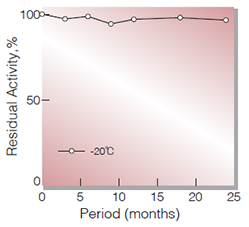
Fig.1. Stability (Powder form)
(kept under dry conditions)
-
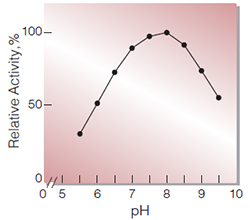
Fig.2. pH-Activity
(37℃ in 0.1M K-phosphate buffer solution)
-
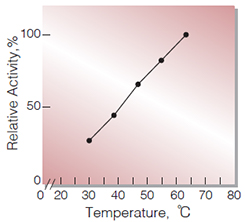
Fig.3. Temperature activity
(in 0.1M K-phosphate buffer,pH 7.0)
-
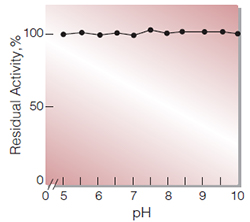
Fig.4. pH-Stability
25℃ 20 hr-treatment with 50mM buffer solution
pH5.0-6.0, acetate buffer
pH6.5-8.5, K-phosphate buffer
pH9.0-10.0, Gly-NaOH buffer -
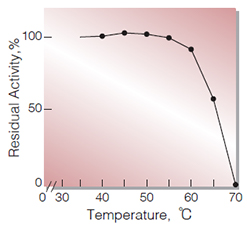
Fig.5. Thermal stability
15 min-treatment with 50mM K-phosphate buffer, pH7.0
活性測定法(Japanese)
1. 原理

4-Aminoantipyrineとフェノールの酸化縮合生成物であるQuinoneimine色素を500nmで測定し,上記反応で生成したH2O2量を定量する。
2.定義
下記条件下で1分間に1マイクロモルのH2O2を生成する酵素量を1単位(U)とする。
3.試薬
- 0.1M K-リン酸緩衝液,pH7.0
- コレステロール溶液〔5.0 mLのTriton X-100に500mgのコレステロールを添加し,ヒーター上で攪拌溶解する。これに90 mLの蒸留水を静かに添加し,攪拌混合後,ヒーター上で30〜60秒煮沸する (溶液は濁る)。次いでゆるやかに攪拌しながら流水中で冷却し(溶液は清澄化する),これに4.0gのコール酸ナトリウム塩(ナカライテスク製)を添加して攪拌溶解させた後,蒸留水で最終液量を100 mLとする〕(溶液は室温で少なくとも1週間は保存可能,もし保存中に濁る場合は,攪拌しながら加温清澄化すれば良い)
- 4-AA水溶液:1.76 % (4-アミノアンチピリン1.76gを水に溶解して100 mLとする)
- フェノール水溶液:6.0 % (フェノール6.0gを水に溶解して100 mLとする)
- POD溶液:Peroxidase 150mg(100プルプロガリン単位/mg)を100 mLの緩衝液(A)に溶解する。
酵素溶液:酵素標品を予め氷冷した0.2 %のBSAを含む20mM K-リン酸緩衝液, pH7.0で溶解し,同緩衝液で0.1〜0.3 U/mlに希釈する。
4.手順
1.下記反応混液を調製する。
| 51.0 mL | K-リン酸緩衝液 | (A) |
| 4.0 mL | 基質溶液 | (B) |
| 1.0 mL | 4-AA水溶液 | (C) |
| 2.0 mL | POD溶液 | (E) |
| (褐色瓶にて氷冷保存) | ||
2.反応混液2.9 mLをキュベット(d=1.0cm)にとり,37℃で約3分間予備加温し,0.1 mLのフェノール水溶液を加えて更に2分間加温する。
3.酵素溶液0.1 mLを加え,ゆるやかに混和し,水を対照に37℃に制御された分光光度計で500nmの吸光度の増加を3〜4分間記録し,その直線部分から1分間あたりの吸光度変化を求める(ΔOD test)。
3.盲検は反応混液に,酵素溶液の代りに酵素希釈液(0.2 % BSAを含む20mM K-リン酸緩衝液,pH7.0)を0.1 mL加え,上記同様に操作を行って1分間当りの吸光度変化を求める(ΔODblank)。
5.計算式
U/ml =
-
ΔOD/min (ΔOD test−ΔOD blank)×3.1(mL)×希釈倍率
13.78×1/2×1.0×0.1(mL)
| = ΔOD/min×4.499×希釈倍率 | |
| U/mg | = =U/mL×1/C |
| 13.78 | : Quinoneimine色素の上記測定条件下でのミリモル分子吸光係数 (cm2/micromole) |
| 1/2 | : 酸素反応で生成したH2O2の2分子のから形成するQuinoneimine色素は1分子である事による係数。 |
| 1.0 | : 光路長(cm) |
| C | : 溶解時の酵素濃度(c mg/mL) |
CONTACT
-
For inquiries and cosultations regarding our products, please contact us through this number.
- HEAD OFFICE+81-6-6348-3843
- Inquiry / Opinion
